Whether a baby should sleep in a pack n play is a common concern for new parents, so it’s important to understand the recommended guidelines and safety measures. When it comes to providing a safe and comfortable sleep environment for your little one, there are a few key factors to consider.
- Babies can sleep in a pack and play until they reach 2 to 3 years of age, or until they reach 30 pounds or approximately 35 inches tall.
- The back sleeping position is considered the safest for reducing the risk of Sudden Infant Death Syndrome (SIDS).
- Pack and plays are regulated to be safe for sleep when used as intended by the manufacturer and according to safe sleep guidelines.
- Different attachments on the pack and play, such as the bassinet and changing table, have their own weight limits.
- Parents should stop using the pack and play when their child reaches certain developmental milestones or if the child does not want to use it anymore.
By keeping these essential tips in mind, you can ensure that your baby sleeps soundly and safely in their pack n play. In the following sections, we will delve deeper into each aspect to provide you with a comprehensive understanding of how to create the perfect sleeping environment for your little one.
Understanding Pack n Plays: A Safe Sleep Environment
A pack n play is a portable crib or play yard that provides a secure and comfortable space for babies to sleep and play. It is designed to meet safety standards and regulations, ensuring that babies can have a safe sleep environment wherever they go. When used correctly, a pack n play can be a convenient and reliable option for parents.
Creating a safe sleep environment in a pack n play is essential to promote healthy and uninterrupted sleep for your little one. Here are some key considerations:
- Choose a pack n play that is sturdy and well-built, with no loose or broken parts. Ensure that the mattress is firm and fits securely in the play yard.
- Place the pack n play in a quiet and well-ventilated area, away from hazards such as cords, blinds, and other potential dangers. Remove any pillows, blankets, or stuffed animals from the sleeping area to reduce the risk of suffocation.
- Always put your baby to sleep on their back, as recommended by pediatricians. This reduces the risk of Sudden Infant Death Syndrome (SIDS).
- Monitor the temperature of the room to ensure that it is neither too hot nor too cold. Dress your baby in light clothing and use a sleep sack or swaddle to keep them cozy without the need for loose bedding.
Table 1: Safe Sleep Guidelines for Pack n Plays
| Recommendations | Details |
|---|---|
| Age and Weight Limits | Babies can sleep in a pack n play until they reach 2 to 3 years of age, or until they reach 30 pounds or approximately 35 inches tall, whichever comes first. |
| Back Sleeping Position | It is recommended to place babies on their backs to sleep in a pack n play to reduce the risk of SIDS. |
| Developmental Milestones | Parents should stop using the pack n play when their child reaches certain milestones, such as attempting to climb out or standing up. |
| User Manual | Follow the manufacturer’s instructions and user manual for specific pack n play models to ensure proper usage. |
By following these guidelines and providing a safe sleep environment in a pack n play, parents can rest assured that their baby will have a secure and comfortable space to sleep and play, both at home and on the go.

Recommended Age and Weight Limits
Babies can sleep in a pack n play until they reach 2 to 3 years of age or until they reach 30 pounds or approximately 35 inches tall, whichever comes first. These recommended age and weight limits ensure the safety and comfort of your little one during sleep time. It is important to follow these guidelines to provide the best sleep environment for your baby.
By adhering to the specific age and weight limits, you can ensure that the pack n play is suitable for your child’s developmental stage. As they grow older and gain weight, it may become necessary to transition them to a different sleeping arrangement. This transition is important for their safety and to ensure they have enough room to move and stretch during sleep.
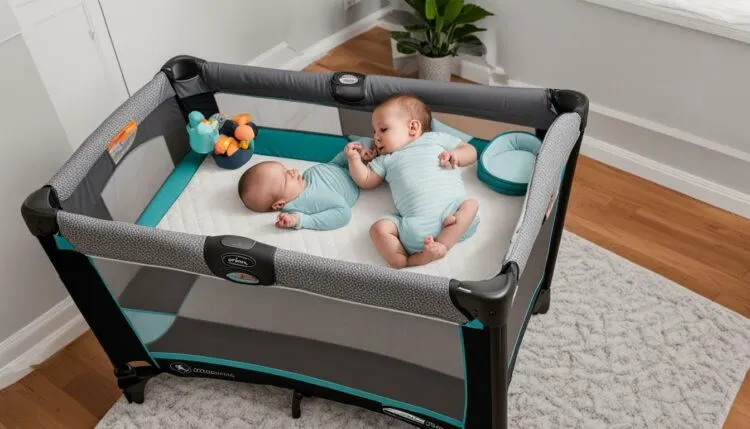
| Age | Weight |
|---|---|
| 2 to 3 years | Up to 30 pounds |
Always consult the user manual provided by the manufacturer to determine the specific age and weight limits for your pack n play model. Following these guidelines will help ensure that your baby sleeps safely and comfortably throughout their early years.
Back Sleeping Position: The Safest Option
The American Academy of Pediatrics recommends placing babies on their backs to sleep to minimize the risk of Sudden Infant Death Syndrome (SIDS). This is because research has shown that back sleeping reduces the likelihood of airway obstruction and overheating, which are both potential risks for SIDS. When using a pack and play for your baby’s sleep, it is essential to always place them in the back sleeping position to ensure their safety and well-being.
According to the American Academy of Pediatrics, “The safest place for your baby to sleep is in the same room where you sleep, but not in the same bed.” A pack and play provides a safe and separate sleep space for your baby, allowing you to keep them close while adhering to safe sleep guidelines. It is important to remember that a firm and flat mattress is crucial for your baby’s comfort and safety. Avoid using soft bedding, such as pillows, blankets, or stuffed animals, as they can pose a suffocation hazard.
Avoid using products or devices that claim to promote safe sleep but are not recommended by reliable sources, such as the American Academy of Pediatrics. These include inclined sleepers, sleep positioners, or any items that restrict movement or change the sleeping position. The back sleeping position is the safest option for your baby and can significantly reduce the risk of SIDS.
Recommended Sleep Positions
| Sleep Position | Description |
|---|---|
| Back | Place your baby on their back to sleep, with their head and face uncovered. |
| Side | Side sleeping is not recommended as it increases the risk of rolling onto the tummy. |
| Stomach | Stomach sleeping is not recommended as it significantly increases the risk of SIDS. |
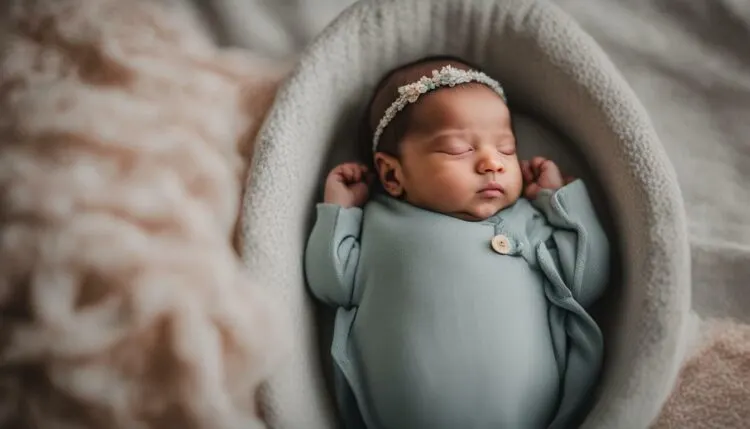
By following safe sleep guidelines and placing your baby in the back sleeping position, you can provide them with a safe and comfortable sleep environment within a pack and play. Always remember to consult the manufacturer’s instructions and user manual for specific guidelines on setting up and using your pack and play properly. Prioritizing your baby’s safety and well-being during sleep is essential, and the back sleeping position is one of the most important factors in ensuring their healthy development.
Safety Standards and Regulations
Pack n plays are regulated by the Consumer Product Safety Commission (CPSC) to meet specific safety standards for sleep and play. These regulations are put in place to ensure the safety of babies and provide parents with peace of mind when using pack n plays for their little ones. When purchasing a pack n play, it is important to look for the CPSC certification, which indicates that the product has passed rigorous safety tests.
One of the key safety standards for pack n plays is to provide a safe sleep environment. This means that the pack n play should have a firm and flat mattress, free from any gaps or spaces where a baby’s head could get trapped. It is also important to avoid using pillows, blankets, or soft toys inside the pack n play, as they can pose suffocation hazards. Additionally, the pack n play should have sturdy sides that are at least 20 inches high to prevent the baby from climbing out.
Another important safety standard is the weight limit for each attachment on the pack n play. For example, if the pack n play includes a bassinet attachment, there will be a specific weight limit for using the bassinet. It is crucial to adhere to these weight limits to ensure that the pack n play remains stable and secure for the baby.
| Attachment | Weight Limit |
|---|---|
| Bassinet | 15 pounds |
| Changing table | 25 pounds |
Parents should also be aware of their child’s developmental milestones when using a pack n play. As the baby grows and reaches certain milestones, such as standing up or attempting to climb out, it may be necessary to stop using the pack n play for safety reasons. Each child is different, so it is important to monitor their behavior and adapt accordingly.
Finally, it is crucial to read and follow the user manual provided by the manufacturer. The user manual contains important instructions on how to assemble, use, and maintain the pack n play. By following the manufacturer’s guidelines, parents can ensure the proper and safe usage of the pack n play for their baby’s sleep and playtime.

Pack n plays often come with attachments, such as a bassinet or changing table, which have their own weight limits that should be followed. These attachments are designed to provide convenience and functionality for parents while ensuring the safety and comfort of their babies.
When using the bassinet attachment on a pack n play, it is important to be aware of the weight limit specified by the manufacturer. This weight limit typically ranges from 15 to 20 pounds, depending on the model. Exceeding this weight limit can compromise the stability of the bassinet and pose a safety risk for your baby.
The changing table attachment is another useful feature found in many pack n plays. However, it also has its own weight limit that should be strictly adhered to. Typically, the weight limit for the changing table ranges from 25 to 30 pounds. It is important to transition your baby to a different surface for diaper changes once they reach this weight limit to ensure their safety.
| Attachment | Weight Limit |
|---|---|
| Bassinet | 15 to 20 pounds |
| Changing Table | 25 to 30 pounds |
Remember, following the weight limits for attachments on your pack n play is crucial to maintain the safety and functionality of the product. Always refer to the user manual provided by the manufacturer for specific weight limits and guidelines.
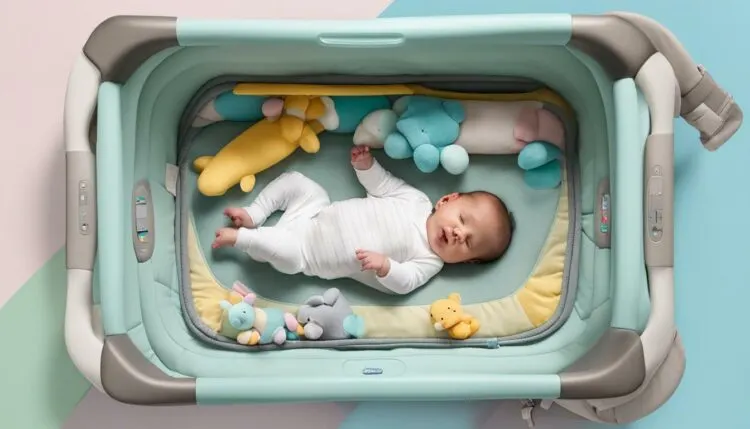
In the next section, we will discuss the developmental milestones that indicate it may be time to transition your baby out of the pack n play.
Recognizing Developmental Milestones for Transitioning
As babies grow and develop, there will come a point where they may outgrow the pack n play and need to transition to a different sleeping arrangement. This transition typically happens when the child reaches certain developmental milestones, such as standing up and attempting to climb out of the pack n play. It’s important for parents to recognize these milestones and make the necessary adjustments to ensure their child’s safety and comfort during sleep.
When a baby starts showing signs of attempting to climb out of the pack n play, it’s a clear indication that they are ready for a new sleeping arrangement. At this stage, the pack n play may no longer be able to contain the child safely, and there is a risk of falls and injuries. Additionally, some babies may simply refuse to sleep in the pack n play anymore, showing a desire for more freedom and space. It’s important for parents to listen to their child’s cues and provide an appropriate sleeping environment that meets their changing needs.
Transitioning from a pack n play to a toddler bed or a regular bed can be an exciting but challenging time for both the child and the parents. It’s essential to create a safe sleep environment in the new sleeping arrangement by using bed rails to prevent falls and ensuring that the mattress is at the appropriate height. Additionally, maintaining a consistent bedtime routine and providing comfort objects, such as a favorite blanket or stuffed animal, can help ease the transition and promote better sleep for the child.
Recognizing Signs of Readiness to Transition:
- Attempts to climb out of the pack n play
- Shows resistance or refusal to sleep in the pack n play
- Height or weight exceeds the pack n play’s recommended limits
- Recognizes and asks for a “big kid” bed

| Age | Weight | Height |
|---|---|---|
| 2 years | 30 pounds | 35 inches |
Importance of Following Instructions and User Manual
To ensure the safety and functionality of a pack n play, it is crucial to carefully read and follow the user manual provided by the manufacturer. This document contains important information on how to assemble, use, and maintain the product, as well as any specific guidelines or restrictions to be aware of. By following the instructions, you can ensure that your baby is sleeping in a secure and comfortable environment.
One of the key reasons for following the user manual is to adhere to safety guidelines. The manufacturer has designed the pack n play with specific features and materials to ensure the well-being of your child during sleep. By following the user manual, you can make sure that you are utilizing the product as intended and not compromising any safety measures.
The user manual also provides guidance on the appropriate weight limits for different attachments and components of the pack n play. This information is crucial for maintaining the structural integrity of the product and preventing any accidents or injuries. By following these weight limits, you can ensure that the pack n play remains stable and secure for your baby.
| Benefits of Following the User Manual: |
|---|
| 1. Safety: Ensures your baby sleeps in a secure and comfortable environment. |
| 2. Adherence to Guidelines: The pack n play is used as intended and meets safety standards. |
| 3. Weight Limit Compliance: Prevents accidents and maintains product stability. |
By following the user manual, you can have peace of mind knowing that you are maximizing the safety and functionality of your pack n play. It is important to remember that not all pack n plays are the same, so it is crucial to consult the specific manual for the model you own.
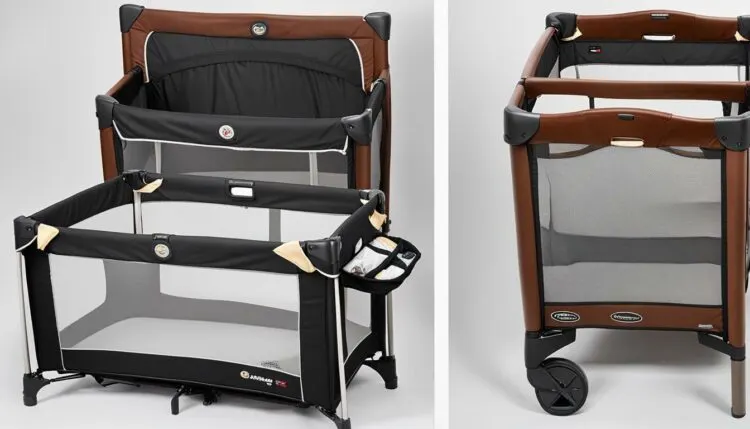
To ensure a safe and comfortable sleep for your baby in a pack n play, here are some important tips and recommendations to consider:
- Choose a firm and snug-fitting mattress: Opt for a mattress that fits properly in the pack n play, without any gaps around the edges. This will help prevent the risk of suffocation or entrapment.
- Avoid using loose bedding: It is crucial to create a clutter-free sleep environment for your baby. Avoid using pillows, blankets, or stuffed animals in the pack n play as they can pose a suffocation hazard. Instead, dress your baby in a sleep sack or wearable blanket for warmth.
- Keep the sleeping area clear: Ensure that there are no cords, toys, or other objects that could potentially entangle or harm your baby in the pack n play. This will help reduce the risk of accidents during sleep.
- Position the pack n play in a safe area: Place the pack n play away from hazards such as curtains, blinds, and cords, which can pose a strangulation risk. Also, avoid placing it near heaters or direct sunlight to maintain a comfortable temperature.
- Monitor the room temperature: It’s important to keep the room at a comfortable temperature for your baby’s sleep. Aim for a temperature between 68 to 72 degrees Fahrenheit (20 to 22 degrees Celsius) and consider using a room thermometer.
- Regularly check the pack n play for wear and tear: Inspect the pack n play regularly for any signs of damage, such as loose screws or torn mesh. If you notice any issues, discontinue use and replace or repair as necessary.
By following these tips and recommendations, you can create a safe and soothing sleep environment for your baby in a pack n play. Remember, always prioritize the safety and comfort of your little one during their precious sleep time.

If you’re planning to travel with your baby and bring along a pack n play, here are some additional tips to ensure a safe and convenient experience:
- Choose a lightweight and portable pack n play: Look for a travel-friendly model that is easy to set up and pack away. This will make it more convenient to transport and use while on the go.
- Inspect the pack n play before each use: Before placing your baby in the pack n play, thoroughly inspect it for any damage or missing parts. Ensure that the locking mechanisms are secure and the mattress is in good condition.
- Bring familiar bedding and sleep essentials: To help your baby feel more comfortable in a new environment, consider bringing their own bedding, such as a familiar blanket or crib sheet. This can help create a sense of familiarity and promote better sleep.
- Set up the pack n play in a safe location: When setting up the pack n play in a hotel room or other accommodation, choose a spot that is away from potential hazards. Avoid placing it near doors, windows, or heavy furniture that could topple over.
- Follow safe sleep guidelines: Even when traveling, it is important to adhere to safe sleep practices. Remember to always place your baby on their back to sleep and avoid using soft bedding or pillows.
With these tips in mind, you can enjoy peace of mind knowing that your baby will have a safe and restful sleep experience, whether at home or on the go.
The Bottom Line: Pack n Plays for Blissful Baby Sleep
Pack n plays provide a versatile and safe sleeping solution for babies, allowing them to have blissful sleep while giving parents peace of mind. These portable cribs are designed to meet the sleep needs of infants and young children, providing a secure and familiar environment wherever you go. Whether you’re traveling, visiting friends and family, or simply need a convenient sleeping space for your little one, pack n plays offer comfort and convenience.
When it comes to ensuring a blissful sleep experience for your baby, pack n plays check all the boxes. They are designed to meet safety standards and provide a secure sleep environment. With a firm mattress and mesh sides, pack n plays allow for proper airflow and reduce the risk of suffocation or overheating. The back sleeping position is recommended to reduce the risk of Sudden Infant Death Syndrome (SIDS), and pack n plays offer a safe space for babies to sleep on their backs.
It’s important to note the recommended age and weight limits for pack n plays. While they can accommodate babies up to 2 to 3 years of age or until they reach 30 pounds or approximately 35 inches tall, always follow the manufacturer’s guidelines for your specific pack n play model. Additionally, pay attention to developmental milestones that may indicate a need to transition your child out of the pack n play, such as standing up or attempting to climb out.
To make the most of your pack n play, be sure to follow the user manual for proper assembly and usage. Different attachments, such as the bassinet and changing table, have their own weight limits, so it’s essential to follow those guidelines as well. By adhering to safe sleep practices, creating a cozy and comfortable sleep environment, and using the pack n play as intended, you can ensure your baby’s blissful sleep experience.

| Key Points | Benefits |
|---|---|
| Offers a safe and familiar sleep environment for babies | Peace of mind for parents knowing their baby is safe and secure |
| Portable and lightweight, making it convenient for travel | Easy to bring along on trips or visits |
| Meets safety standards and guidelines for secure sleep | Reduces the risk of SIDS and suffocation |
| Allows for the back sleeping position | Reduces the risk of SIDS |
| Adjustable height settings and attachments for added convenience | Adapts to the needs of growing babies |
The Evolution of Pack n Plays: Newer Features and Models
Over the years, pack n plays have evolved to incorporate new features and designs, offering more options and convenience for parents. Manufacturers have recognized the need for versatility in these portable cribs, ensuring they cater to the ever-changing needs of both babies and their caregivers.
One notable feature that has become increasingly popular is the inclusion of a detachable bassinet. This allows parents to have their newborns closer at hand during the early months, providing easy access for nighttime feedings and comforting. The bassinet attachment is designed to provide a comfortable and safe sleeping surface for infants, ensuring they can enjoy restful sleep while being close to their parents.
Another innovation in pack n plays is the addition of a built-in changing table. This convenient feature eliminates the need for a separate changing station, saving space and providing a dedicated area for diaper changes. With sturdy construction and easy-to-clean surfaces, these changing tables offer a practical solution for busy parents on the go.
| Newer Features | Benefits |
|---|---|
| Detachable Bassinet | Allows newborns to sleep closer to parents for easy access and comforting. |
| Built-in Changing Table | Provides a dedicated area for diaper changes, saving space and improving convenience. |
| Compact Folding Design | Makes transportation and storage easier, ideal for travel and small spaces. |
In addition to these practical features, modern pack n plays often come with a compact folding design. This allows easy transportation and storage, making them ideal for travel or for use in small living spaces. The ability to fold the pack n play into a compact size makes it convenient to take on trips or store away when not in use.
With advancements in technology, some pack n plays also incorporate electronic features. These can include soothing sounds, calming vibrations, or even mobiles to entertain and engage babies. These additional features provide a multi-functional aspect to the pack n play, enhancing the overall sleep experience for little ones.
As parents continue to prioritize safety, comfort, and convenience, manufacturers are constantly innovating pack n plays to meet these expectations. The evolving features and models offer more options for parents to choose from, ensuring that their babies can sleep soundly and securely.
Key Points:
- Newer pack n plays offer features such as detachable bassinets and built-in changing tables for added convenience.
- Compact folding designs make transportation and storage easier, perfect for travel and small spaces.
- Some pack n plays incorporate electronic features like soothing sounds or calming vibrations.
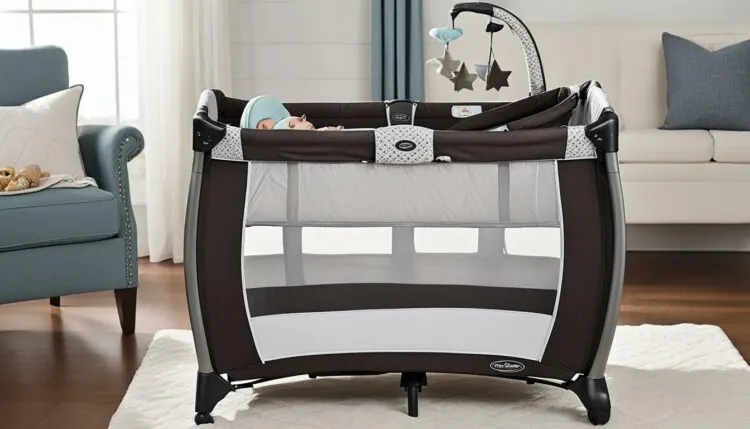
Understanding how long babies can sleep in a pack n play and following essential safety tips is crucial for creating a safe and comfortable sleep environment for your little one.
Babies can sleep in a pack and play until they reach 2 to 3 years of age or until they reach 30 pounds or approximately 35 inches tall, whichever comes first. This provides a convenient and portable option for parents to ensure their baby’s sleeping needs are met, whether at home or on the go.
The back sleeping position is considered the safest option for babies to reduce the risk of Sudden Infant Death Syndrome (SIDS). Placing your baby in a pack and play in the back sleeping position promotes better airflow and helps to maintain a clear airway during sleep.
It’s important to note that pack and plays are regulated to meet safety standards. When used as intended by the manufacturer and according to safe sleep guidelines, they provide a secure and comfortable sleeping environment for your baby.
Parents should also be aware of the weight limits for different attachments on the pack and play, such as the bassinet and changing table. Following these weight limits ensures the structural integrity of the pack and play and keeps your baby safe.
As your child grows and reaches certain developmental milestones, it’s important to monitor their use of the pack and play. If your baby starts standing up, trying to climb out, or shows a strong preference for not using it anymore, it may be time to transition to a different sleep arrangement.
Remember to always consult the user manual for specific pack and play models to ensure proper usage. Following the manufacturer’s instructions is vital for the safety and well-being of your baby.
By understanding how long babies can sleep in a pack n play and adhering to essential safety tips, you can create a safe and comfortable sleep environment that promotes healthy sleep patterns and peace of mind for both you and your little one.
FAQ
Q: How long can a baby sleep in a pack n play?
A: Babies can sleep in a pack and play until they reach 2 to 3 years of age, or until they reach 30 pounds or approximately 35 inches tall, whichever comes first.
Q: What is the safest sleeping position for babies in a pack n play?
A: The safest sleeping position for babies in a pack n play is on their back. This reduces the risk of Sudden Infant Death Syndrome (SIDS).
Q: Are pack n plays regulated for safe sleep?
A: Yes, pack and plays are regulated to be safe for sleep when used as intended by the manufacturer and according to safe sleep guidelines.
Q: Are there weight limits for attachments on a pack n play?
A: Yes, different attachments on a pack n play, such as the bassinet and changing table, have their own weight limits. It’s important to follow the user manual for specific pack n play models to ensure proper usage.
Q: When should I stop using a pack n play?
A: Parents should stop using a pack n play when their child reaches certain developmental milestones, such as standing up, trying to climb out, or if the child has a strong personality and doesn’t want to use it anymore.
Q: How can I create a safe sleep environment in a pack n play?
A: To create a safe sleep environment in a pack n play, use a firm mattress, avoid loose bedding, and follow safe sleep guidelines, such as placing the baby on their back.
Q: Why is it important to follow the user manual for a pack n play?
A: It is important to follow the user manual for a pack n play to ensure proper and safe usage. The manual provides instructions specific to the pack n play model and helps prevent any potential accidents or hazards.
- Sagittarius Man & Gemini Woman Love and Sex Compatibility - January 31, 2024
- Taurus Ascendant Rising Personality Traits in Men (Guide) - January 31, 2024
- How to Seduce and Attract a Sagittarius Man (Seduction Tips) - January 31, 2024
